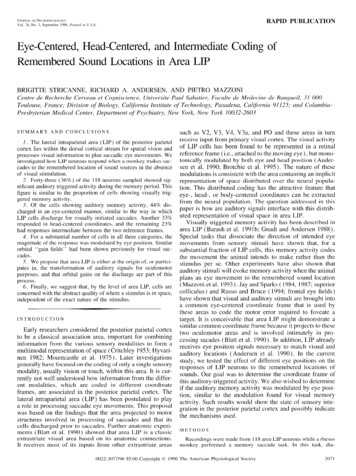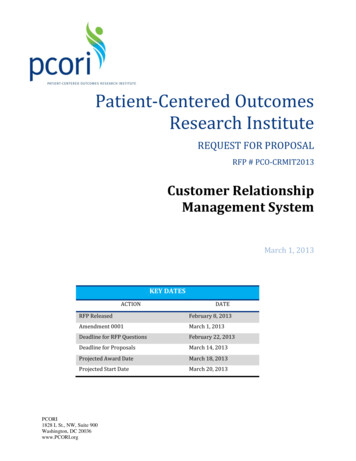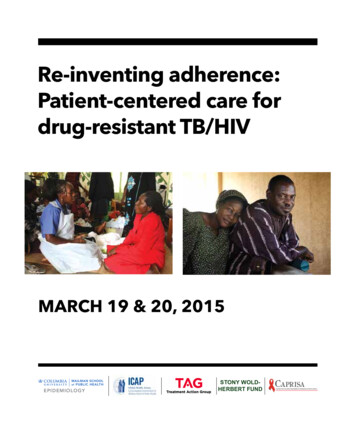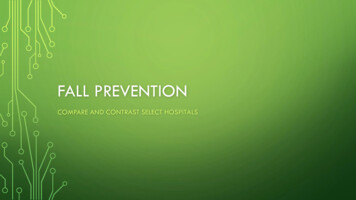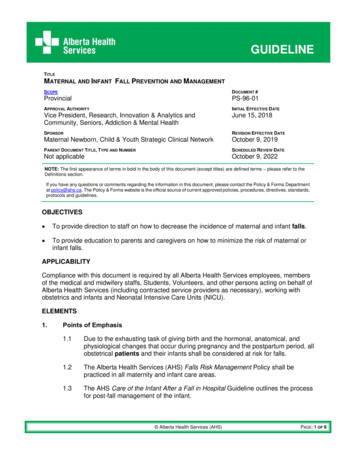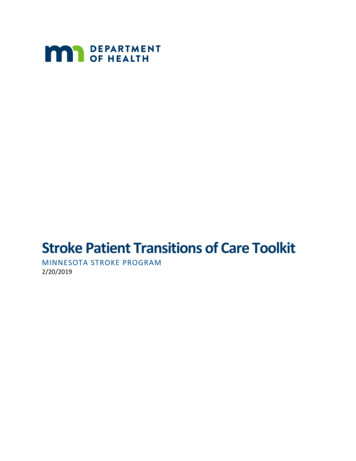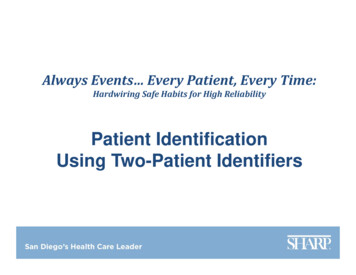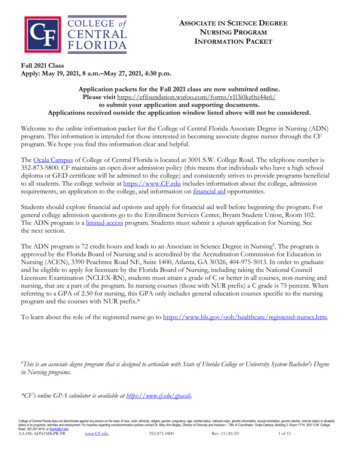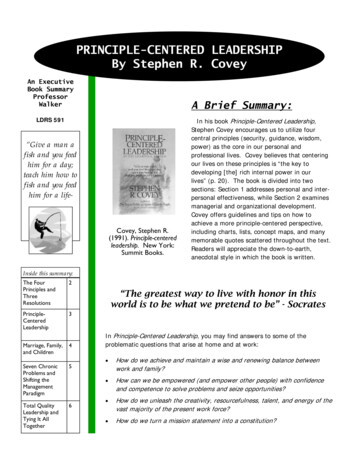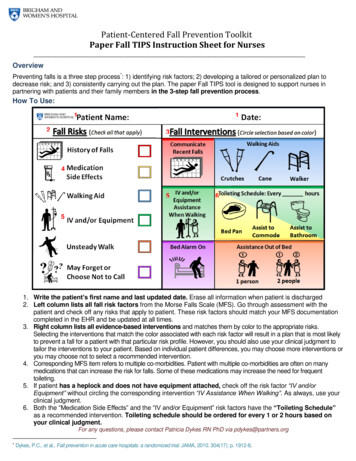
Transcription
Patient-Centered Fall Prevention ToolkitPaper Fall TIPS Instruction Sheet for NursesOverviewPreventing falls is a three step process*: 1) identifying risk factors; 2) developing a tailored or personalized plan todecrease risk; and 3) consistently carrying out the plan. The paper Fall TIPS tool is designed to support nurses inpartnering with patients and their family members in the 3-step fall prevention process.How To Use:121345651. Write the patient’s first name and last updated date. Erase all information when patient is discharged2. Left column lists all fall risk factors from the Morse Falls Scale (MFS). Go through assessment with thepatient and check off any risks that apply to patient. These risk factors should match your MFS documentationcompleted in the EHR and be updated at all times.3. Right column lists all evidence-based interventions and matches them by color to the appropriate risks.Selecting the interventions that match the color associated with each risk factor will result in a plan that is most likelyto prevent a fall for a patient with that particular risk profile. However, you should also use your clinical judgment totailor the interventions to your patient. Based on individual patient differences, you may choose more interventions oryou may choose not to select a recommended intervention.4. Corresponding MFS item refers to multiple co-morbidities. Patient with multiple co-morbidities are often on manymedications that can increase the risk for falls. Some of these medications may increase the need for frequenttoileting.5. If patient has a heplock and does not have equipment attached, check off the risk factor “IV and/orEquipment” without circling the corresponding intervention “IV Assistance When Walking”. As always, use yourclinical judgment.6. Both the “Medication Side Effects” and the “IV and/or Equipment” risk factors have the “Toileting Schedule”as a recommended intervention. Toileting schedule should be ordered for every 1 or 2 hours based onyour clinical judgment.For any questions, please contact Patricia Dykes RN PhD via pdykes@partners.org*Dykes, P.C., et al., Fall prevention in acute care hospitals: a randomized trial. JAMA, 2010. 304(17): p. 1912-8.
Patient Name:Increased Riskof Harm If You Fall(Check all that apply)Date:(Circle selection based on color)History of FallsMedication SideEffectsWalking AidsCommunicateRecent Fall and/orRisk of HarmCrutchesIV AssistanceWhen WalkingCaneWalkerToileting Schedule: Every hoursWalking AidBed PanIV Pole or EquipmentBed Alarm OnAssist toCommodeAssist toBathroomAssistance Out of BedUnsteady WalkMay Forget orChoose Not to CallBed Rest1 person2 peopleFall TIPS Brigham & Women’s Hospital 2016; do not alter without written permission.
Fall T.I.P.S.* Training SlidesPatricia Dykes PhD, RN, FAAN, FACMIBrigham and Women’s Hospital*Tailoring Interventions for Patient Safety
Overview Review the types of patient falls Review the components of an evidence-based fallprevention program– Universal fall precautions (all patients)– 3-Step Fall Prevention Process1. Fall risk assessment2. Personalized fall prevention planning3. Strategies to ensure consistent implementation of thefall prevention plan Review Fall TIPS as a tool to implement the 3-stepfall prevention process Complete two case studies Discuss the role of the PCA in fall prevention
Is My Patient At Risk For Falling?TYPES OF PATIENT FALLS
Types of Falls: Not PreventableUnanticipated physiological falls: Occur in those who have no risks for falling Caused by physiologic changes—Such as seizure 8% of fallsMost difficult to prevent. Some may not bepreventable.Source: Morse, J.M. (2009). Preventing patient falls. (2nd ed). New York: Springer. Published, 2009.
Types of Falls: PreventableAccidental falls: Occur in those who have no risks for falling Usually caused by environmental hazard/errorin judgment 14% of fallsPrevented through universal fall precautionsSource: Morse, J.M. (2009). Preventing patient falls. (2nd ed). New York: Springer. Published, 2009.
Types of Falls: PreventableAnticipated physiological falls: Occur in those who have risk for falling The fall risk assessment (Morse Fall Scale)completed by the nurse every shift predictsthis type of fall 78% of falls**Prevented through fall risk assessment,personalized care planning, and carrying outthe planned interventions consistently**Source: Morse, J.M. (2009). Preventing patient falls. (2nd ed). New York: Springer. Published, 2009.
Is My Patient At Risk For Falling?FALL PREVENTIONSTRATEGIES
Evidence-based FallPrevention Strategies Universal Fall Precautions 3-Step Fall Prevention Process
Universal Fall Precautions Cornerstone of anyhospital fall preventionprogram Apply to all patients atall times
Examples of Universal Fall Precautions Clear pathways.Wipe up spills immediately.Provide access to call bell.Provide non-skid footwear.
3-Step Fall PreventionProcess1.Conduct fall risk assessment (FRA) with the patient at the bedside2.personalized to each area of risk identified through FRA3.Consistent implementation of the preventative interventions (based ontailored plan)Patient engagement is a key component of eachstep of the 3-step process.
Fall Risk Assessment Morse Fall Scale Completed every 8 hoursby the nurse Used to identify eachpatient’s individual riskfactors for falling Used to identify theinterventions to decreasepatient risk for falling
Risk Factors for Falls Identified byMorse Fall Scale History of falling Secondary diagnosis—Associated with incontinence, vision problems,multiple medicines, orthostatic hypotension Ambulatory aidIV therapy/heparin (saline) lockGaitMental statusSource: Morse, JM. Predicting Patient Falls. CA: Sage Publications, 1997.
Recommended InterventionsHistory of falling (in past 3 months): Most significantindicator for falling Use safety precautions. Communicate risk status via plan of care, change ofshift report, and signage. Document circumstances of previous fall.PCA: Ask the patient about previous falls. Collaborate with thenurse on implementing a plan to prevent similar falls.Patient who have fallen in the past are likely to fall againand under similar circumstances. Plan accordingly!
Recommended Interventions, cont.Secondary diagnosis Think about factors that may increase risk for fallsthat are related to symptoms of multiple medicalproblems and side effects from the medications totreat medical problems:— Illness/multiple medicines— Side effects such as dizziness, frequent urination,and unsteadiness— Vision problems Consider implementing a toiletingschedule.PCA: Ask the nurse if the patient requires frequent rounding/toileting due to symptomsof medical problems or medication side effects.
Recommended Interventions, cont.Ambulatory aid Use ambulatory aid at bedsideif needed. Review dangers of usingfurniture or hospital equipmentas an ambulatory aid. Assess ability to useambulatory aid. If no ambulatory aid but needsit, consider PT consult.PCA: Make sure patients have their ambulatory aid when walking. Remind patient aboutthe dangers of using furniture as an aid in the hospital.
Recommended Interventions, cont.IV therapy/heparin (saline) lock Implement toileting/rounding schedule.Tell patient to call for help with toileting.Review side effects of IV medications.Assist patient with IV pole when walking.PCA: Remind the patient that the IV will cause them to urinate morefrequently and to call for help with toileting. Conduct frequent rounding.
Recommended Interventions, cont.Gait Assess gait when patient hasambulatory aid as baseline. Help patient get out of bed.– Determine if patient requires1 or 2 person assist. Consider PT consult.NormalWalkswithpatientshead erect,armsswingingfreely at the side, striding without k gait:Stooped,but able to lift head without losing balance. If furniture required, uses as aaid whenwalking.guide (feather-weight touch). Short steps, may shuffle.Impaired gait: Difficulty rising from chair (needs to use arms; several attempts to rise). Headdown; watches ground while walking. Cannot walk without assist; grabs at furniture orwhatever available. Short, shuffling gait.
Recommended Interventions, cont.Mental status Use bed or chair alarm. Place patient in visible location. Encourage family presence. Do frequent rounding.PCA: make sure bed/chair alarm are turned on when leaving the room. Donot leave patients in the bathroom unattended.Mental status test: “Are you able to go to the bathroom alone, or do you need assistance?” Normal: Patient response is consistent with orders or kardex. Overestimates/forgets limits: Patient response is inconsistent with orders or unrealistic.
ABCS of HarmPatient is at high risk for injury if they fall with:– Age: 85 years old or older, frailty– Bones: osteoporosis, risk or history of fracture, etc– Coagulation: risk for bleeding, low platelet counts, ortaking anticoagulation– Surgery (recent): lower limb amputation, major abdominalor thoracic surgeryIntervention Communicate the patient is at an increased risk for injury ifthey fall. Emphasize the importance of following theirpersonalized fall prevention plan.
PAPER FALL TIPS
MFS and Fall T.I.P.S.Fall TIPS uses MFS data to plan interventions to preventpatient falls Review the areas of risk identified by the MFS for aspecific patient. On the Fall TIPS tool, select those identified risks thencircle interventions for each area of risk. The tool is color coded to indicate the evidence-basedinterventions for each area of risk.
Case Study 1 John, an 82-year-old man with diabetes was admitted toBWH medical unit with chest pain and shortness ofbreath. On admission, patient was found to be alert andoriented. He had IV and was placed on cardiac monitor. During admission interview, patient reported that withhis cane, he was independent with walking andtransfers. However, the nurse noted that the doctor’sorder was for walking with cane and assistance only. With further questioning, the patient reported that hehad fallen at home several times over past year, mostrecently last month. As nurse assisted patient to bathroom, she noted thatinitially he used bedside table and other furniture asguide and needed to be reminded to use his cane. Once he was given cane, patient walked with short,steady steps to bathroom.
AnswersJohn 05/12/20161
Case Study 2 Jane, an 86 year old woman with high blood pressure,diabetes and chronic lower back pain is admitted to aBWH medical unit with severe abdominal pain andnausea. The patient is alert, oriented and pleasant. Sheis on a long list of medications. She is short of breath when walking. During the interview, the patient states thatoccasionally she uses a cane. Upon further questioning,the patient revealed that she fell at home last monthand the month prior. When walking to the bathroom, the nurse and nursingassistant noted that the patient’s was gait steady withthe use of a cane. The patient is NPO and is started onintravenous fluids. She is too weak to carry the IV poleto the bathroom alone.
PAPER FALL TIPS
AnswersJane5/12/16 2
Regular Audits Regular audits will be conducted on your unit toensure the Fall TIPS protocol is adopted into theworkflow. Audit questions assess: Whether or not the Fall TIPS poster is correct andupdated. Whether or not patients and family are engaged in the3-step fall prevention process. Audit questions:1. Is the patient’s Fall TIPS poster updated andhanging at the bedside?2. Can the patient/family verbalize the patient’s fallrisk factors/personalized fall prevention plan?
The Role of Patient Care Assistant in Fall Prevention Utilize universal fall precautions for all patients Communicate with nurse about each patient’srisk factors and the plan to prevent a fall Assist/remind patients as needed regarding fallprevention interventions Communicate interventions via bedside shiftreport Reinforce use of the tool/plan with nurses Provide feedback to the nurse related to thefall prevention plan Ensure the tools are updated by RN
Examples of Universal Fall Precautions Clear pathways. Wipe up spills immediately. Provide access to call bell. Provide non-skid footwear.File Size: 1MBPage Count: 31
